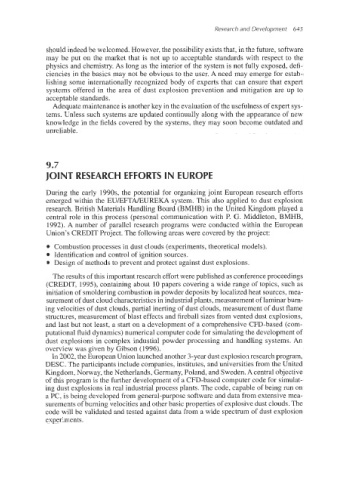Page 678 - Dust Explosions in the Process Industries
P. 678
Research and Development 645
should indeed be welcomed. However, the possibility exists that, in the future, software
may be put on the market that is not up to acceptable standards with respect to the
physics and chemistry. As long as the interior of the system is not fully exposed, defi-
ciencies in the basics may not be obvious to the user. A need may emerge for estab-
lishing some internationally recognized body of experts that can ensure that expert
systems offered in the area of dust explosion prevention and mitigation are up to
acceptable standards.
Adequatemaintenance is another key in the evaluation of the usefulness of expert sys-
tems. Unless such systems are updated continually along with the appearance of new
knowledge in the fields covered by the systems, they may soon become outdated and
unreliable.
9.7
JOINT RESEARCH EFFORTS IN EUROPE
During the early 1990s, the potential for organizing joint European research efforts
emerged within the EU/EFTA/EUREKA system. This also applied to dust explosion
research. British Materials Handling Board (BMHB) in the United Kingdom played a
central role in this process (personal communication with P. G. Middleton, BMHB,
1992). A number of parallel research programs were conducted within the European
Union’s CREDIT Project. The following areas were covered by the project:
Combustion processes in dust clouds (experiments,theoretical models).
@ Identification and control of ignition sources.
0 Design of methods to prevent and protect against dust explosions.
The results of this importantresearch effort were published as conferenceproceedings
EDIT, 1995), containing about 10 papers covering a wide range of topics, such as
initiation of smolderingcombustion in powder deposits by localized heat sources,mea-
surementof dust cloud characteristicsin industrialplants, measurement of laminarburn-
ing velocities of dust clouds, partial inerting of dust clouds, measurement of dust flame
structures, measurement of blast effects and fireball sizes from vented dust explosions,
and last but not least, a start on a development of a comprehensive CFD-based (com-
putational fluid dynamics) numerical computer code for simulatingthe development of
dust explosions in complex industial powder processing and handling systems. An
overview was given by Gibson (1996).
In 2002, the European Union launched another 3-year dust explosionresearch program,
DESC. The participants include companies, institutes, and universities from the United
Kingdom, Norway, the Netherlands, Germany, Poland, and Sweden.A central objective
of this program is the further development of a CFD-based computer code for simulat-
ing dust explosions in real industrial process plants. The code, capable of being run on
a PC, is being developed from general-purpose software and data from extensive mea-
surements of burning velocities and other basic properties of explosive dust clouds. The
code will be validated and tested against data from a wide spectrum of dust explosion
experiments.

